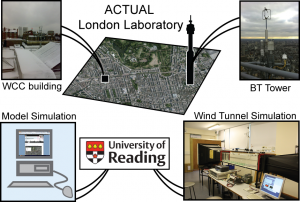By Dr Alex Boon
Investment into our urban areas is of key importance as we continue into the 21st century and face a changing climate. Our urban areas are expanding and becoming ever more densely populated. Furthermore, urban areas are known to suffer more with the heat in the summer, but provide an oasis from the winter chill, due to the well-publicised ‘urban heat island effect’.
London is home to over 8 million people and welcomes approximately an additional million people into the city every working day. The challenges of adapting London to the changes that may be wrought by climate change have been considered by the London Climate Change Partnership. Questions that can be asked of city sustainability and adaptation must be asked at various different scales; individual buildings, individual neighbourhoods and across the city at large. How might a building be designed to manage energy efficiently? How might a neighbourhood be designed to ensure that air pollutants are rapidly dispersed? How might a city be adapted to cope with the threat of an intensifying urban heat island? Through harnessing the urban wind, can we use the city’s rooftops to produce energy close to where it is needed most?
ACTUAL as an integrated ‘laboratory’ incorporating London platform measurements, wind tunnel simulations and model simulations. WCC is the Westminster City Council building on London’s Marylebone Road.
Some of these questions and more are currently being studied by members of the ACTUAL and REFRESH research teams based in the expanding urban meteorology group at Reading. The ACTUAL project (Advanced Climate Technology: Urban Atmospheric Laboratory) is nearing completion. The project involved study of the urban climate at various scales: from instruments located in and around a building studying air movement and building ventilation, through to an instrument located on top of London’s BT Tower, surveying the city at large. The work was also supported by wind tunnel experiments in the University of Surrey’s EnFlo laboratory and the Department of Meteorology wind tunnel here at the University of Reading. Examination of the data in urban areas is important for verification of forecasting models such as the Met Office UKV, which operate on a high resolution (1.5 km) scale. Other modelling approaches are examined in light of the urban wind data provided by the project, including the models used by engineers to estimate wind loading on tall buildings and others used to site urban wind turbines. The data provided by the London laboratory are freely available and are already being used by the UK Met Office and industrial partners Arup.
The results of ACTUAL also feed into the newly established research project REFRESH . This aims to place the building user at the centre of the debate about ventilation, air quality and the indoor environment. The research will examine the importance of indoor working environments for human performance and help to determine the optimal indoor environment for the users by examining the facets of human performance and the building microclimate in the context of the city.
For more detailed information:
Barlow, J. F., Halios, C. H., Lane, S. E., and Wood, C. R., 2014. Observations of urban boundary layer structure during a strong urban heat island event. Environ. Fluid Mech., 1-26
Drew, D. R., Barlow, J. F., and Lane, S. E., 2013. Observations of wind speed profiles over Greater London, UK, using a Doppler lidar. Journal of Wind Engineering and Industrial Aerodynamics, 121, 98-105
Drew, D. R., Barlow, J. F., and Cockerill, T. T., 2013. Estimating the potential yield of small wind turbines in urban areas: A case study for Greater London, UK. Journal of Wind Engineering and Industrial Aerodynamics, 115, 104-111

